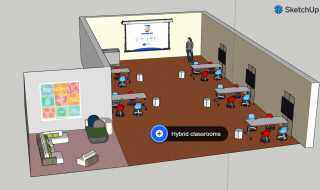“We are genuinely bringing Europe closer together, by getting things up and running together and building something that works for everyone.”
The CHARM-EU experience
Collaborating across borders
European university alliances are on the rise, with 21 Dutch institutions, both universities of applied sciences and research universities, participating in this European Commission initiative. CHARM-EU, the alliance including Utrecht University, comprises nine institutions across eight countries. Managing IT across various systems, legal frameworks, and operational methods presents significant challenges.
Key facts
Who: Janina van Hees and Ecca Berhitu
Position: Project manager and Lead IT Strategy at CHARM-EU and Enterprise Architect.
Organisation: Utrecht University / CHARM-EU
Challenge: Diverse IT systems, regulations, and practices complicate seamless collaboration among universities across different countries.
Solution: Implementing practical solutions such as hybrid classrooms and developing interoperable systems to facilitate more efficient collaboration.
Janina van Hees and Ecca Berhitu from Utrecht University explain how they are addressing the challenge of interoperability. “The joint master's programme is the main educational product within our alliance,” says Janina van Hees, Project Manager and Lead IT Strategy at CHARM-EU. “In September, the fifth cohort will start; for the first time, all nine partners will be involved. Students follow the programme simultaneously at multiple locations. That is quite an undertaking.”
Pragmatic solutions
To make this possible, CHARM-EU developed hybrid classrooms, enabling students to attend classes simultaneously from the location of their own campuses. The University of Barcelona handles the enrolment process, but all institutions need access to the same student data and must process it in their own systems. “It can be done manually, but naturally that’s not the preferred approach,” says Janina. “We’re exploring whether we can automate this using the Open Education API.”
Then there’s the issue of authentication: students need to be able to log into the learning environment. How do you manage that across institutions and countries? “And ultimately, you want to issue a diploma,” Janina continues. “At the moment, it still has to be signed physically in five locations, and soon in nine. That process takes four months! We’re looking into digital signatures, but legislation is getting in the way. In practice, we often have to look for pragmatic solutions. If it works, we can improve the processes from there.”

Janina van Hees and Ecca Berhitu. Photographer: Carolina Nijenhuis.
National contexts
“That doesn’t mean we’re simply being reactive,” says Ecca Berhitu, Enterprise Architect at Utrecht University. “In fact, the challenges we encounter, such as identity management, course catalogues, data standards, are the usual suspects for issues that can cause problems. What we uncover within the CHARM-EU alliance is the specific context in which these issues arise. By engaging with partner institutions, you come across perspectives and considerations you wouldn’t normally think of from the standpoint of a Dutch university.”
“Scheduling, admissions, and enrolment… everyone referred to them slightly differently and had their own interpretation.”
“In Hungary, for example, the mother’s surname is always recorded in the student’s data record,” says Janina. “That’s due to national legislation. In other countries, that same information is often used as a security question in case someone forgets their password. So we’re working with systems that may appear similar on paper, but in practice are shaped significantly by national context. And that’s exactly why this work matters: we are genuinely bringing Europe closer together: by getting things to work collectively and building something that works for everyone. We call that a seamless experience. It requires us to overcome barriers, but we also learn such a lot from one another. Starting from pragmatic solutions, we can work towards sustainable improvements in the long run.”
Building a common language
Collaborating across national borders requires more than just technical solutions. This also holds true for collaboration between alliance partners in the area of technology. “When we first brought all the IT staff together two years ago, it turned out that we were all using different terms for the same things,” Ecca explains. “Scheduling, admissions, and enrolment… everyone referred to them slightly differently and had their own interpretation of what they meant."
To provide a clearer framework for collaboration, the team used the HERM (Higher Education Reference Model) capability model. “We systematically worked through all the capabilities,” says Ecca. “For each element, we discussed what it meant in the context of our alliance, and where IT could play a role. Colleagues involved in educational content also took part in those discussions.” In this way, a shared understanding and a common focus emerged.
"Without interoperability, you'll keep running into barriers."
What makes HERM so effective is that it is structured around the learner journey: from orientation and application to assessment and graduation. That structure helped align IT and non-IT colleagues. By now, HERM has really gained traction within the alliance. The fact that the model is in English and accessible to various disciplines has certainly contributed to that.
The team mapped out the entire student journey. “For each phase, we looked at what was working well and where there were friction points, from both the student’s perspective and a process point of view.” This fit-gap analysis revealed bottlenecks and areas for short-term improvement. The result was an overview that helped set priorities and clearly identify the impact of decisions.

Model of a CHARM-EU Hybrid Active Learning Classroom, made by Nancy Rodriguez.
A single support organisation
One of the first priorities on CHARM-EU’s joint IT roadmap was to establish a shared support structure. This resulted in the creation of the Joint Virtual IT Office, which distributes IT responsibilities across the partner institutions. “We began by identifying the areas where support was needed,” Janina explains. “Then we started matchmaking: who has expertise in which area, where is capacity, and who is keen to take on which topics?”
Each support area is now managed by one or two institutions. “This approach allows us to make effective use of local expertise, without requiring every institution to cover all work areas. Together, we maintain a comprehensive support package, across institutions and national borders. Few alliances have set things up in this way. I’m quite proud of that!”
Alliance as testing ground for IT innovation
For Utrecht University, CHARM-EU is more than just an international collaboration. It serves as a testing ground for digital cooperation across multiple boundaries. “It’s a well-defined alliance with a manageable group of students,” says Janina. “Despite the complexity of the national contexts, it’s an ideal environment for experimentation. You learn a great deal about how international collaboration works, and what aspects can be applied more broadly.” Ecca adds: “Within an alliance like this, you actually have a lot of freedom to innovate. Very little is set in stone, so you can truly build something from the ground up.”
The importance of interoperability
At the same time, working within CHARM-EU makes it clear just how important interoperability is. “The more you want to set up jointly, the more complex it becomes,” says Ecca. “If you’re not yet interoperable, in other words, if systems don’t connect properly, then collaboration comes at the expense of a less-than-seamless student experience.
Sometimes it seems like a minor detail,” he continues, “such as registering the mother’s surname. But if you don’t resolve those kinds of issues, you can’t properly automate processes. And without interoperability, you’ll keep running into barriers. In Europe, we’re simply not yet at the point where everything can run in a fully automated and seamless way. Until then, we need to keep seeking collaborations and working on solutions together.”
What is a European university alliance?
European university alliances are international partnerships between higher education institutions. They are part of the European Commission's European Universities Initiative, which stems from a proposal made by French President Macron in 2017. The initiative contributes to the development of a strong European Education Area in which students, teachers and researchers can move and cooperate freely. A total of 64 alliances are active.
